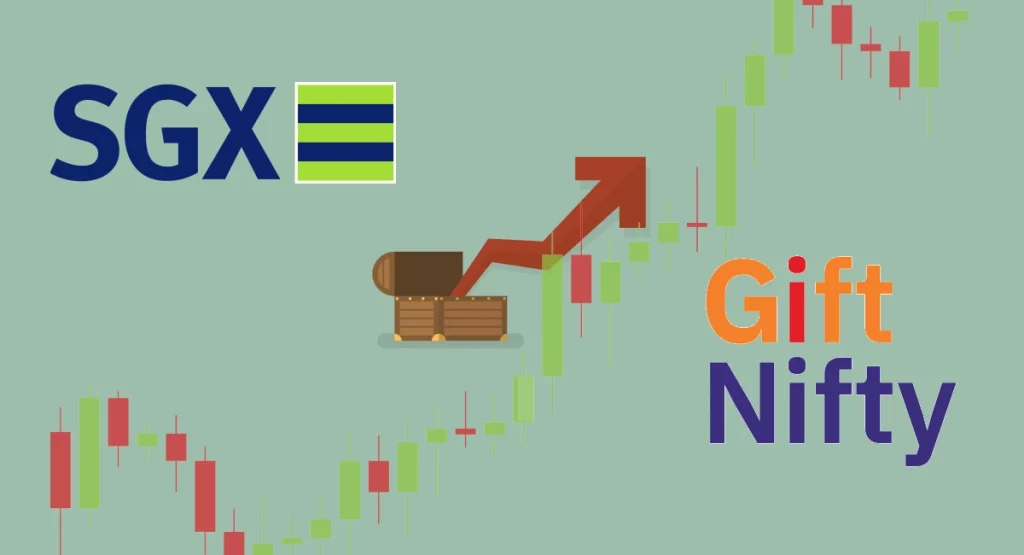“SGX Nifty is now GIFT Nifty.” This headline was no less than a thunderbolt for market mavens! Why? You may ask. Because SGX Nifty was a predicting tool for the Nifty 50 index. SGX Nifty provided info on whether the price of a stock on the Nifty 50 index would rise or fall. But from 3rd July onwards SGX Nifty is dead and substituted by GIFT Nifty!

The absence of this predicting tool has shaken the traders to their core. So what is Gift Nifty? What has changed? What are the reasons behind this? How will it affect the investors? Can you trade in Gift Nifty? And the questions go on and on! If you are also hovering through these queries then stick to our article to know everything about this replacement saga.
Stay tuned!
Backstory: SGX Nifty & its Significance
23-year-old SGX Nifty was the protagonist of the Indian stock market. The end of its existence has raised numerous doubts among folks. Well, let’s look at the backstory of SGX Nifty.
The year 2000: Nifty Futures Contract

It was the era of the 90s. The nifty 50 indexes were launched in April 2022. The acronym NIFTY is a blend of “National Stock Exchange” and “Fifty.” At that time only the biggest 50 companies of India were listed on it. Four years passed by (the year 2000), but it couldn’t put a significant impression on the market and traders. So, it innovated itself by launching a new derivative of the NIFTY 50 Index. And that new product was the “Nifty Futures Contract.”
What’s that? Well, it was a kind of betting platform. Here, you could bet whether the Nifty 50 will rise or fall on a respective day. How? By locking in the current price of Nifty 50. Just by putting in a small fee you could make a profit if the bet goes in your favor.
Sounds quite advantageous. Isn’t it?
Participation of Foreign Investors in the Nifty Futures Contract
After seeing the positive response to the Nifty Futures Contract from Indian traders, NSE wanted to expand its arms. Why? To attract foreign investors and foreign investments in India. So, what did it do? NSE marked an agreement with SGX i.e. Singapore Stock Exchange. And thus SGX Nifty was born.
SGX Nifty

This platform was made with the collaboration of NSE and SGX. NSE supplied data related to the Nifty’s prices to the SGX. Thereby, SGX created a similar index and offered future contracts in which foreign investors could trade from Singapore. In other words, foreign investors participated in the futures contracts trade through SGX Nifty.
Benefits of SGX Nifty
SGX Nifty was a huge success. Why? Because of the following reasons-
- Singapore is an all-time major financial hub.
- Seamless participation of foreign investors in the Indian trading system.
- Trading could be done with the US Dollar, therefore no deal in Indian Rupee.
- No Capital Gains Tax in Singapore. Thus, investors kept all of their profits to themselves.
Soon, SGX Nifty futures became hugely popular. It was worth billions of dollars.
Significance of SGX Nifty
Apart from allowing global players to trade in Indian derivatives, SGX Nifty offered another exclusive advantage to foreign traders. And what’s that? It is the prediction! As you have read in the introductory para- SGX Nifty was used as a predicting tool for Indian traders.
How?
Due to the time difference between India and Singapore. The time zone of Singapore is 2 hours and 30 minutes ahead of India. When trading begins in Singapore at 9 am, it is 6:30 pm in India. So, by looking at the results of SGX Nifty at 6:30 am, Indian traders could predict the results of the Nifty futures contract in India.
Thus, SGX Nifty became a leading indicator of Indian stock market sentiment. The SGX Nifty futures contract indicates how Nifty will open on a given day. It was checked by traders before the Nifty opening hours at 9:15 am.
Why was SGX Nifty replaced by GIFT Nifty?
Everything was going well and good until the relationship between NSE and SGX took a bitter turn. NSE observed that there was five times more trading activity in SGX Nifty. It was way more than its original version i.e. Nifty futures contract. The popularity of SGX Nifty was draining money from India. Eventually, it affected the growth of the Indian futures market.
The story didn’t end here. SGX was planning to launch a futures contract for the individual stocks of the Indian market. This means they wanted to expand beyond the Nifty 50 index.
This was the last nail in the coffin. As a result, NSE canceled the deal including SGX Nifty. There were multiple court sessions too! Thereafter, SGX Nifty was declared dead.
Investors were going through a rough patch, desperately waiting for a ray of hope. And that was GIFT Nifty!
What is GIFT Nifty?
Here comes the climax of this whole “SGX Nifty replacement episode.” Have you heard about the new financial capital of India? The GIFT City! It refers to Gujarat International Finance Tec-City. It is an enormous 900-acre campus stretching from Gandhinagar to Ahmedabad. All right! So what’s so special about it? You may wonder. It is a Multi-Services Special Economic Zone and the first international financial services center in India. It is made to attract foreign investment in India therefore typical strict Indian rules don’t apply there.
GIFT City is regulated by IFSCA i.e. International Financial Service Centre Authority. It is a regulator as well as a policy maker of GIFT City.
NSE saw GIFT City as a golden opportunity to continue the incoming dollars and foreign investments in India. It offered a deal to SGX that allowed foreign investors to trade the nifty index and that too in dollars. This deal was the NSE IFSC-SGX connect contract. SGX couldn’t afford to lose SGX Nifty’s contracts worth $7.5 billion. So, it accepted the deal. The whole SGX Nifty flew to India and got a new name i.e. GIFT Nifty.
In this deal, the NSE will be handling the trades. All these stories boil down to one question. Did the role of SGX end here? The answer is “No.” Really? Yeah! Although the role of SGX has reduced but not ended. All that SGX has to do is to verify the trades and maintain the order.
GIFT Nifty: A New Identity of SGX Nifty
GIFT Nifty is the first cross-border initiative that connects the capital markets of India and Singapore. You can assume it is a new identity for SGX Nifty. All open positions in SGX were shifted to NSE IX from July 3 onwards.
Thus both Indian and Singaporean stock exchanges will get mutual benefits and earn money.
Thus, SGX Nifty’s existence ceased on 30th June 2023. It was delisted from Singapore Stock Exchange and listed on the GIFT IFSC. It was renamed “NSE IFSC Nifty.”
Timings of GIFT Nifty
It is accessible for 21 hours in two sessions-
- 1st Session: 6:30 am to 3:40 am
- 2nd Session: 4:35 am to 2:25 am
These sessions overlap with the trading hours of Asia, Europe, and the US.
Significance of GIFT Nifty

Just SGX Nifty futures were traded on Singapore Exchange (SGX), GIFT Nifty Futures were traded on National Stock Exchange (NSE). The NSE IFSC-SGX connect contract was signed by both NSE and SGX. Thus, NRIs and Foreign Investors can trade in Indian stocks. It will provide the following benefits-
The first benefit is an exemption from different types of taxes. NSE IX operates from an SEZ. Due to this traders will get exemptions from-
- STT (Securities Transaction Tax)
- CTT (Commodity Transaction Tax)
- DDT (Dividend Distribution Tax)
- Capital Gains Waivers
Secondly, GIFT Nifty is more advantageous for non-resident players as compared to SGX Nifty. When Indian entities set up a subsidiary in GIFT City, they will be treated as non-residents. Thus, they will get numerous tax exemptions.
Third and the most important advantage of GIFT Nifty is it has no impact on foreign retail traders. Really? Yes. Because it is just a simple migration or shift from one trading exchange to another. Here, the countries don’t really matter too much. Because profits and tax exemptions are the exclusive features that the traders need! And these features are already given in GIFT Nifty.
Thus, you can say that the significance of GIFT Nifty is far more than SGX Nifty, especially for India.
Can we trade GIFT Nifty in India?
By now you must have realized the fact GIFT Nifty is established to attract foreign investments and especially in dollars. NSE IX released a statement recently.
“Any trading member – Indian/foreigner, registered/ non-registered – setting up its office through a subsidiary/branch model in GIFT city. They can start trading in the GIFT Nifty products by taking membership of NSE IX.”
Now you might be hovering over a query. “Can we trade Gift Nifty in India?”
So, here is the answer-
“Being an Indian retail investor you won’t be eligible to trade in GIFT Nifty.”
Why? You may ask.
See, it is specially created for foreign investors. So, you aren’t eligible for trading in GIFT Nifty under the Liberalised Remittance Scheme (LRS). But here is a trick that is generally used by Indian brokers and subsidiaries. Curious to know? They sign up for trade through non-residents and family-owned offices of wealthy Indians as clients.
Final Words
GIFT Nifty is a significant approach to strengthening India’s financial ecosystem. It provides opportunities to foreign investors and traders by providing greater access to the Indian market. It will also improve the bond between Indian and global markets.
Thus, you won’t have to look at Singapore anymore to know the direction of trade in Nifty futures. You just have to look at Gujarat at 6:30 am because this is the time when the first session of GIFT Nifty begins!
FAQ
Who Created Gift Nifty?
NSE (National Stock Exchange)
Where is GIFT Nifty?
GIFT Nifty is located in GIFT City, Gujrat
What is GIFT Nifty trading time?
1st Session: 6:30 am to 3:40 am
2nd Session: 4:35 am to 2:25 am
What is GIFT Nifty launch date?
3rd July 2023

